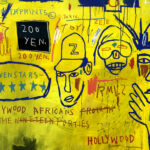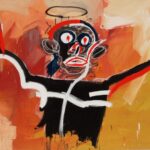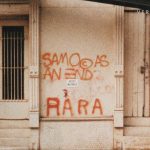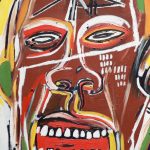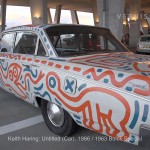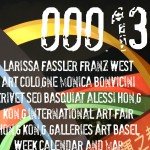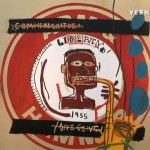Currently on view at Artstübli gallery in Basel is an exhibition that is dedicated to the “Godfather of Street Art”, the Canadian artist Richard Hambleton (1952-2017). The show features photographs by Vera Isler and Thomas Christ that document Hambleton’s works and his live, as well as two original artworks by Richard Hambleton. In this video we take a look at the exhibition and talk to Thomas Christ, who talks about his time in New York, his encounters with Richard Hambleton, Keith Haring and Jean-Michel Basquiat, and the art historical significance of Urban Art / Street Art.
Richard Hambleton gained fame with his rapidly painted shadow figures which appeared overnight on the walls of buildings in New York and various cities in Europe. In a few seconds and life-size with sweeping brushstrokes in urban space. Also known as the Shadowman, Hambleton left behind over 400 in Manhattan alone. In 1984, Hambleton traveled to Europe five times passing through 24 major cities, including Basel, in the shadow of the night, leaving his signature figures everywhere. The reason for the trips was an invitation to participate in the 1984 Venice Biennale.
The exhibition is presented by Artstübli – Urban Art & Culture, Balzer Projects and the estate of Vera Isler (Verein Blaue Blume, ART-Nachlassstiftung, Bern). The show runs until June 25, 2022.
> Right-click (Mac: ctrl-click) this link to download Quicktime video file.
Exhibition text (translation from German):
New York City at the beginning of the 1980s. A city is bleeding to death, the Bronx is burning, the Subway is a “no-go area”. The murder rate is unbelievably high: there are over 30 murders per 100,000 inhabitants. Where today tourists take photos at three o’clock in the morning in New York’s Times Square, back then not even the New Yorkers themselves dared to go after dark. In the 1980s, capitalism and racism showed their ugly faces. From Lower Manhattan to the Bronx – abandoned buildings, poverty, homelessness and crime. There was a lack of prospects for Black and Latino residents of the city, especially the youth.
But already growing on this soil were the seedlings of another New York, a culture that many did not see or did not want to see. Despite, or perhaps because of, this hopelessness, underground creativity flourished. Small artist-run galleries, artists collaboratives, off spaces, and the graffiti scene emerged. The latter consisted of groups of mostly young men who sprayed graffiti with spray cans on subway cars and the walls of houses in the desolate boroughs, thus creatively living out and immortalizing themselves. Always in the hope that everything would get better at some point, that they would be discovered and become famous.
Two people from Basel – the artist and photographer Vera Isler and the art historian, photographer and graffiti connoisseur Thomas Christ – regularly visited the city as early as the late 1970s and early 1980s. They had their cameras in their luggage and sharpened their analytical and artistic eye in the USA. They developed a very individual visual language and brought home a new perspective on political and social realities.
Isler and Christ are chroniclers of American contemporary history. Their photographs are not only invaluable contemporary documents; even today they sharpen our view of the sociological and cultural context in which the artistic and conceptual development of the city’s urban art and underground culture must be seen.
These life-size figures, brushed/sprayed onto walls in seconds with broad brushes and black paint, appeared in dark corners and alleys, as well as on high walls and facades. Sometimes they stood casually leaning against a house wall, sometimes they jumped at passers-by from high walls to scare the (unwilling) public at any time of day or night. Richard Hambleton is therefore still reverently called “The Godfather of Street Art”. He is considered a pioneer in urban art and inspires renowned artists like Banksy, Blek le Rat and JR to this day. He was neither a street artist nor an illegal sprayer. He grew up in a middle-class environment in Vancouver, Canada, and enjoyed an education at an established art academy. The studio was his place of artistic creation, but on the street he entered into direct exchange with the public through his shadow figures. What makes them exciting is the power of the viewer’s imagination – that split second experience when you see the figures that matter. (Quote: R. Hambleton)
On their forays through Lower Manhattan and the Bronx, Isler and Christ met Keith Haring, who would later become an art market heavyweight. Haring and Hambleton knew each other well. It was probably through him that they became aware of the “Shadow Men.” “In 1979, 3 men met in Club 57. Thus the holy trinity of Richard Hambleton, Jean-Michel Basquiat and Keith Haring was born. Theirs was a perfect storm of creativity, concept and circumstance, marking a new chapter in art history and changing the face of New York’s iconic East Village art scene forever.”
Richard Hambleton saw himself as a conceptual artist and wanted his art, not him, to be the focus. At the same time, Hambleton was vain, secretive, and often met his counterpart with arrogant disapproval. He was aware of his talent and demonstrated a strong artistic self-confidence to the outside world.
In the 70s and 80s Basel developed more and more into an international art scene. Richard Hambleton arrived in 1984 with his shadow figures and immortalized himself in 12-13 places in the city. At that time, however, hardly anyone knew Hambleton’s work, and when the figures appeared overnight, the astonishment was great. Even the Basler Zeitung, which at the time was already following his mysterious activities, puzzled over makers and motives. Amazing – an urban art actor of the New York scene helped to establish an urban art culture in Basel!
The rich collection of photographs by the two Basel photographers will be made available to the public for the first time in this exhibition. Selected views from New York and Basel are shown. Vera Isler also photographed Richard Hambleton in his studio in New York. Her images show a handsome young man in splattered overalls who was well aware of his status and promising career as an artist. They, too, are being presented to an audience for the first time. The photos of Thomas Christ are a part of his legendary graffiti photographs, which have already reached cult status since the 80s in a (out-of-print) publication.
About Vera Isler
Vera Isler-Leiner, (1931-2015) was sent to Switzerland in 1936 with her two sisters to escape the Nazi terror. Her parents were murdered in 1942 in Bełżec, a Polish extermination camp. Having spent her childhood in a orphanage, she later worked as a medical-technical laboratory assistant. Her true passion, however, was making art – tapestries, collages, prints and sculptures.
During a six-months visit to the US in the early 1980s, Isler switched her creative focus to photography. Fearless and adventurous, she searched for good motives and stories in the streets and alleys of New York. The lives of people of all ethnicities and classes fascinated her as much as this newly discovered art form – Graffiti – which she encountered all over Lower Manhattan. “Shadowmen”, the mysterious ghostly figures which appeared overnight, became her favorite subjects. She had the exceptional fortune – likely through an introduction by her friend Keith Haring – to visit and photograph the artist, Richard Hambleton. She followed him to Venice in 1984 and photographed his spooky figures which he painted on a short stop-over in Basel. Her extensive collection of “Shadowman” photographs pays tribute to this.
Isler published her stories in countless newspapers and magazines, such as “Das Magazin”, “NZZ”, “Du”, “Spiegel”, “Stern”, “ART” and “Weltwoche”. International recognition in the 1990s with portrait photography. In “Rollenwechsel” (1992) and “Face to Face” (1994), she created black and white large-format portraits of famous artists and photographers, showing them in their apartments or studios. In 2000 Vera Isler published “Auch ich”, an autobiography which situates her often tragic experiences within the chronicles of her battle against breast cancer.
About Thomas Christ
The Swiss Thomas Christ from Basel was one of the first to document the phenomenon of graffiti and street art with his photos from 1982 and ’83. He used New York graffiti artists as well as Keith Haring and Richard Hambleton as models of illegal design in public space.
Thomas Christ, born in Zurich in 1953, has lived in Basel since 1974, where he successfully completed his law school studies with a doctoral thesis on the copyright of filmmakers. Among his most artistically successful series are his works on the theme of “Schaufensterspiegelungen” from the years 1974-1979, published in 1980 by the Galerie von Bartha in Basel, as far as his published collection of New York Subway Graffiti, a documentation from the Bronx that is both artistically and sociologically significant.
“Urban Graffiti” was his second publication, having already released “Subway Graffiti” in 1984. There the focus was on painted New York Trains and Walls, which he had photographed during the same period. Poem allowed a glimpse into his Blackbook, which are shown as a collection at the end of the book.

